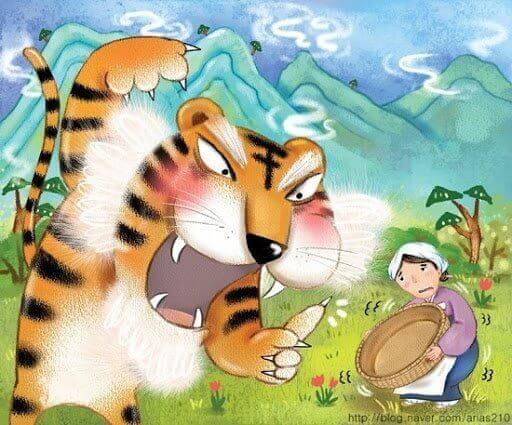Korean Folk Stories You Heard in Kdramas that Are Actually Real

I think, and I hope many will agree, that Korean folk stories are one of the most fascinating parts of fantasy K-dramas, especially in titles like Tale of the Nine Tailed, Island, Revenant, and Goblin. In these series, folk stories are prominent in how the plot is written.
Some of these folk stories are for those who, like me, are a genre fan and have started to become familiar with them. Still, others are less known, especially to people in Western countries whose typical religious beliefs are far from Shamanism and Buddhism, the two biggest influences concerning these traditions.
If you want to know more about Korean culture and Korean folk stories and to be updated about your favorite K-pop idols or K-dramas, check out the other articles on www.Daebak.co! If you cannot travel to Korea this year but want to have a piece of Korea with you, check out the Daebak Shop!
#Shamans
Let's start with something easy: whether in fantasy K-Dramas or "normal" K-Dramas shamans are a rather regular figure in the Korean landscape. It is not strange, even for younger non-believers, to ask for their help, and we often see them being consulted when it comes to marriage, romantic relationships, or hoping to find a way to overcome bad luck.
But who are shamans in real life? Shamanism is a folk religion in Korea that counts many deities and evil spirits, almost too many.
In this vast pantheon, the shamans (in Korean mudang 무당), usually females who have been through a traumatic experience (a prolonged sickness or a life-changing event) and came enlightened, are the ones who can help people gain luck through good spirits or get rid of evil ones.
To achieve the desired outcome, they perform various rites, called Kut, which can vary a lot, depending on the regional tradition followed by the shaman, and include, among others, possessions.
#Imugi (from Tale of the Nine Tailed)
In the series, the Imugi (이무기) is an evil earth snake, born during the Silla kingdom as the ninth child of a Jingol family, one of the highest ranks in ancient Korea, he had physical deformities similar to a snake and, for this reason, his father tried to get rid of him by closing the child inside a cave with plague victims. Here, he was eaten by them and transformed into a white serpent. Despite trying to become a dragon by waiting beneath the water for a 1000 years, he did not succeed and tried various times to possess Lee Yeon (the main character) 's body to become a mountain spirit.
East Asian dragons look very different from European dragons. As you may know, if you are a fan of Miyazaki's Spirited Away, they usually do not have wings and have long beards.
Imugi, in particular, were lesser dragons. They are somewhat similar to giants snakes who, similarly to the one in Tale of the Nine Tailed in many legends, aspire to become true dragons by finding a Yeonju, which was a wish-fulfilling jewel (the Korean version of Hindu Cintāmaṇi) or by training.
In other stories, they were hornless creatures condemned to never become dragons, and there are also many accounts of Imugis as benevolent water creatures that bring good luck.
To sum it up, Imugi, in Korean folk stories, is not the evil creature we see in the series but more of a big benevolent snake.
#Jangseung (from Tale of the Nine Tailed)
He appears in the series as a mysterious drunkard old man who often helps out Nam Ji-Ah, the female protagonist.
In Korean traditions, the Jangseung (장승) is a wooden or stone totem pole traditionally placed at the edges of villages to protect them from demons and worshipped by the population as tutelary deities. They are also decorated depending on their "genders." Male Jangseung usually wear elaborate headpieces and have inscriptions like "Great General of All Under Heaven." Female Jangseung, on the other hand, have similar inscriptions but reciting "Female General of the Underworld."
Jangseungs are divided into three types depending on where they are stationed: village, temple, and public guardians.
They are very similar to Dol Hareubang (Korean: 돌 하르방), rock statues typical of Jeju Island that were supposed to bring protection and fertility, that you can find, for example, in the series Island.
#Jeoseung Saja
Jeoseung Saja (저승 사자), or Grim Reapers, are also a creatures that appeared in many different series. The most famous among them, of course, is Guardian: The Lonely and Great God, known as Goblin. More recently, they were featured as the main characters in the series Tomorrow.
In both series, they are dressed in a modern style. In Goblin, in particular, they wear a hat, an idea taken from another legend regarding the Goblin's hat, which grants the power of invisibility to whoever wears it.
These creatures, whose name in Korean literally means “messengers of Death”, are usually portrayed as servants of King Yeomra, fifth of the Ten Kings of the Underworld and its supreme ruler. Unlike King Yeomra, who judges the sins of those who come before him, their role is simply accompanying the souls of the dead to the Underworld.
The most known among the Korean folk stories regarding Joseung Saja is the one that talks about General Sineui. He is a man who tried to trick the Joseung Saja more than once to escape death. At first, by planting orange trees around his house, which were believed to ward off evil, but Joseung Saja managed to enter by using a peach tree.
He then tried to escape again by piercing a silver pin on his head, which also wards off evil.
However, Joseung Saja managed to take him by surprise and hit him, removing the pin. After all this ordeal, General Sineui also escaped the Underworld, but when he came back, his body was already buried…which caused him to die again!
#Dangsan namu
Dangsan namu (당산나무) appeared in recent K-dramas Revenant and Island. These village guardian deity trees are regarded as a medium between our world and the heavenly world. For this reason, this tree is also a central part of many rituals, like the ones made to greet the god of heaven and those made to bring luck to the villagers.
In the legend regarding Dangun, considered the god-king founder of Gojoseon, the first Korean kingdom, we see him landing right under one of these trees to corroborate their role in Korean folk stories as a connection between our world and the world of gods.
#Gwisin
Gwisin (귀신) in Korean folk stories is the term used to indicate ghosts, creatures that are widely spread across all world's belief systems.
With that being said, though, Korean gwisins are a bit different from how we, at least in Western countries, usually imagine ghosts. In fact, here, ghosts are simply people who have died, and they are usually divided into two types: good ghosts and evil ghosts, a distinction solely based on how they used to be when they were still alive.
Korean Gwisin comes in many "variations," like the infamous Cheonyeo Gwisin or virgin ghost, the spirit of a young woman who could not fulfill her filial duty due to her premature death, that is now bitter and angry.
An example, which is quite comedic, is the series Oh My Ghost:
Another type of gwisin that appears in many folk stories and that recently infested the second season of Alchemy of Souls is the Mul Gwisin, or water ghost, another evil spirit that drowns people who come too close to its habitat, usually as the name suggests, a body of water.
The last type of gwisin I will discuss is the Agwi, or the hungry/starving ghost. This is another creature that recently appeared in the series Revenant.
The hungry ghosts appear in various Asian religions, Hinduism, Taoism, Buddhism and, last but not least, local folk stories.
They are depicted as in a constant state of hunger and thirst, and legends typically believe these gwisin to have been thieves, higher officials, merchants, or property owners who led a sinful life and came back to earth to try to accommodate their jealousy, hate, greed, and envy.
They are not inherently evil, as ghosts, but more guided by their insatiable needs. The good side of their cursed destiny is that by repenting for many years, they can manage to atone for their sins.
This is just a small compendium of the many creatures contained in Korean folk stories. There are many other creatures and many series that, by mixing different traditions, keep creating new interesting renditions of these folk creatures.
If you, like me, enjoy myths and legends, check out the K-Dramas on the list, and if you have other creatures you want us to talk about, let us know in the comments!











Leave a comment